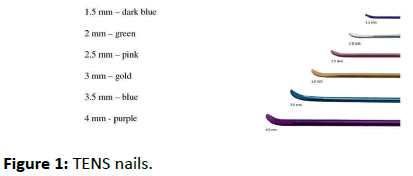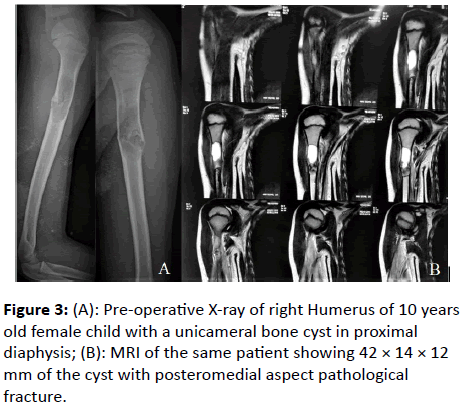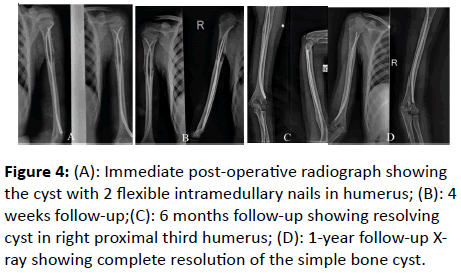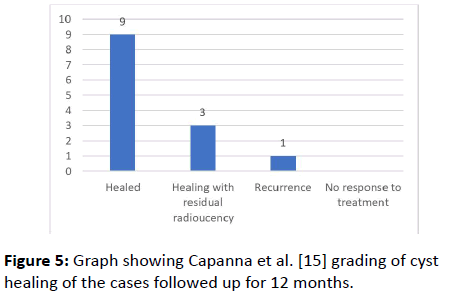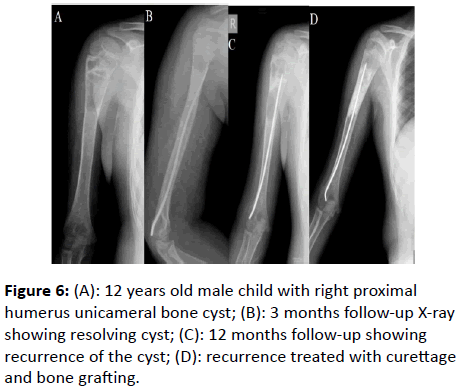Flexible Intramedullary Nailing for Unicameral Bone Cyst of Humerus in Children: A Case Series
Venkatesh Gupta SK and Ajay Shringeri Satish
Venkatesh Gupta SK and Ajay Shringeri Satish*
Department of Orthopaedics, JJM Medical College, Davangere, India
- *Corresponding Author:
- Ajay Shringeri Satish
Deptartment of Orthopaedics
JJM Medical College, Davangere, 577004, India
Tel: +917259990905
E-mail: ajayshringeri@gmail.com
Received date: July 30, 2019; Accepted date: August 20, 2019; Published date: August 30, 2019
Citation: Gupta VSK, Satish AS (2019) Flexible Intramedullary Nailing for Unicameral Bone Cyst of Humerus in Children: A Case Series. J Clin Exp Orthop Vol.5 No.3:69.
Copyright: © 2019 Gupta VSK, et al. This is an open-access article distributed under the terms of the Creative Commons Attribution License, which permits unrestricted use, distribution, and reproduction in any medium, provided the original author and source are credited.
Abstract
Introduction: Unicameral bone cyst is benign fluid-filled lesions in pediatric long bones before skeletal maturity, most commonly in the proximal humerus. These are diagnosed as an incidental finding where the child presents with a pathological fracture.
Aim: Purpose of this study is to evaluate the outcome of treating unicameral bone cyst with or without pathological fracture by flexible intramedullary nailing viz., TENS.
Methods: During the period of June 2015 to June 2019, 13 cases of a paediatric unicameral bone cyst located in proximal 1/3rd of humerus admitted to Bapuji hospital and Chigatteri general hospital, J.J.M medical college, Davangere. Mean age was 9 years. 8 cases presented with pathological fracture.
Results: Out of 13 cases 9 patients had complete healing of cyst at 12 months follow-up, 3 patients had a residual cyst and 1 patient developed recurrence after initial healing response.
Conclusion: Titanium intramedullary nailing is a safe and efficient procedure for unicameral bone cyst as it provides immediate mechanical stability and also cyst decompression allowing early mobilization and return to their daily activities.
Keywords
Unicameral bone cyst; TENS; Elastic intramedullary nailing
Introduction
A unicameral bone cyst is a benign fluid-filled lesion in the metaphysis of skeletally immature long bones most commonly found in the paediatric population [1]. They form 3% of all bony lesions in the pediatric age group. They usually occur in the humerus (55%-65%) and femur (25%-30%), rarely they present in tibia, fibula, radius, and ulna. Very rarely, a unicameral bone cyst may be found in the pelvis [2]. Majority of these lesions are diagnosed incidentally in an event of pathological fracture [3]. Various aetiologies have been proposed for the formation of the unicameral bone cyst, entrapped synovial tissue [4], venous blockade leading to restrained blood supply [3]. Venous blockade results in elevated intraosseous pressure and increased osteoclastic activity from the epithelium of the cyst wall [5]. Pathological fracture occurring through this can cause growth arrest due to its proximity to the epiphysis [6]. Most of these cysts tend to heal with satisfactory stability by the time of skeletal maturity but never remodel completely to a radiologically normal bone either with or without treatment.
Various treatment spectrum includes aspiration and injection of corticosteroids [7-9] curettage and bone grafting [10,11] subtotal resection and bone grafting [12], and percutaneous bone marrow injection [13,14]. Flexible intramedullary nailing offers early mobilization in a pathological fracture and also has the advantage of intramedullary decompression of an active bone cyst and also fracture stabilization.
In this study, we present the results of flexible intramedullary nailing of unicameral bone cyst of the humerus with pathological fractures in the paediatric population.
Materials and Methods
13 cases of proximal third humerus unicameral bone cyst in the paediatric population of age group 5-18 years (mean age 9 years) admitted in Bapuji hospital and Chigatteri general hospital during the period of June 2015 to June 2019. Out of these cases, 8 were male and 5 females. These patients were diagnosed based on X-ray radiographs and MRI for assessment of cyst diameter. Out of 13 cases, 8 cases had pathological fractures and others were diagnosed incidentally for chronic pain in the proximal humerus (Table 1). 9 cases had presented in the right humerus and 4 in the left side, active cyst which are very close to the growth plate were seen in 5 cases. Latent cysts were seen in 8 cases. Out of 5 active cysts, 4 cases had a pathological fracture (Table 2). Children presenting with pathological fracture were stabilized with U-slab to prevent displacement of the fracture fragments and also alleviate pain. Regular follow-ups for assessment of fracture healing and cyst resorption and bone remodeling was done with radiographs. Parents were informed and written consent to participate in the study was taken, which was approved by the research committee of the institution.
| No. cases | Right side | Left side | Male | Female |
|---|---|---|---|---|
| 13 | 9 | 4 | 8 | 5 |
Table 1: Demographic data.
| Right | Left | Total | |||
|---|---|---|---|---|---|
| With fracture | Without fracture | With fracture | Without fracture | ||
| Active cyst | 3 | - | 1 | 1 | 5 |
| Latent cyst | 2 | 4 | 1 | 1 | 8 |
Table 2: Data regarding the stage of the simple bone cyst at presentation.
Principle of titanium elastic nailing system
TENS works on the principle of symmetric bracing action of two elastic nails inserted into the metaphysis. Each nail bears against the inner side of the bone at three points. There are two types of intramedullary constructs of TENS namely C-C and C-S constructs. This construct gives flexural, translational, axial and rotational stability at the fracture site (Figure 1).
Pre-requisite for TENS for optimum fracture stability
Nail diameter of the individual nail should be 40% of the narrowest diameter of the diaphysis (Flynn ’ s formula: Nail diameter=0.4 × canal diameter)
Nails should be contoured with the long bend such that apex of convexity lie at the fracture level to provide optimum threepoint fixation
Both the nails should be bent symmetrically and to the same extent
The nails are pre-bent so that the height of the curve is three times greater than the diameter of the medullary canal
Always the nails of the same diameter are used to prevent loss of reduction towards the stronger nail
The entry point of both the nails should be at the same level
When inserted nails should have maximum cortical contact at the fracture site in the opposite directions
Surgical technique
With a child under general anaesthesia, under fluoroscopic guidance. 2 flexible titanium nails (implant from SHARMA Orthopaedic (India) Pvt. Ltd). are selected according to the diameter of the medullary canal. Entry site being posterolateral to the lateral supracondylar ridge, 2 cm proximal to the distal humerus epiphysis. After incision over the lateral supracondylar ridge, with bone awl entry site is made. Titanium nails appropriate for the child are selected, usually, 2 or 3 mm based on the width of the medullary canal. Nails are pre-bent to have a three-point fixation configuration in the medullary canal. Two nails are inserted one after the other under the image intensifier guidance avoiding the proximal and distal humerus epiphysis. Nails are passed in a retrograde fashion one proximal to the other till the proximal humerus metaphysis. Before wound closure, the ends of the nails were trimmed to an extent they are 1cm outside the bone. Care is taken such that the protruded ends do not irritate the soft tissue surrounding it and also allow for easy removal (Figure 2).
Post-operative protocol
Post-operatively child was put on slab till suture removal because two flexible intramedullary nails provided adequate biomechanical stability. Shoulder movements were encouraged from 1st post-operative day. Injectable antibiotics for 3 days followed by oral antibiotics till suture removal. Prolonged use of antibiotics is practiced in our setup owing to a less hygienic environment in a rural government setup and low personal care and compliance. Regular surgical site dressing was done on 4th and 10th day post-operatively with suture removal after 10 days (Figures 3 and 4). Strenuous activities were deferred until radiological evidence of fracture and cyst healing was appreciated on serial radiographs. Clinical and radiographic controls were performed at 4, 8 and 12 weeks and further after, 6 and 12 months. Criteria, as described by Capanna et al. [15], was used to classify the cyst healing.
Results
Among the 13 cases, the mean time interval between the diagnosis and operation was 5 days. At the end of 12 months follow- up, 9 cases showed complete healing of the cyst with well formation of cortex and were classified as Capanna 1. 3 cases had residual radiolucency at 12 months follow-up X-rays, but most of the cyst being filled with new bone formation and good cortical thickening at the site of bone cyst and were classified as Capanna 2. These cases were further followed up and 2 cases showed complete healing at the end of 18-20 months, another case still had residual radiolucency but with good consolidation of bone. One case developed recurrence after 10 months, which had an initial healing response but later developed large areas of radiolucency and cortical thinning and was classified under Capanna 3. None of the cases showed no response to treatment with flexible titanium nails. In 9 patients who had complete healing of the cyst with good bone consolidation, Titanium nails were removed around 14-16 months interval. 3 patients with residual cyst are being followedup on a regular basis. One patient with recurrence was treated with exchange nailing and bone grafting after curettage of the cyst and being followed-up regularly.
Healing rate in our study was 92.3% at 12 months follow-up. Mean hospital stay was 5 days. 1 case had superficial wound infection which was treated with regular dressing and a short course of oral antibiotics (Figures 5 and 6). None of the cases had implant failure. one case had difficulty in removal of nails and were left in situ for removal during the later period. None of the cases had physical damage, growth disturbances or neurovascular injuries (Table 3).
Figure 5: Graph showing Capanna et al. [15] grading of cyst healing of the cases followed up for 12 months.
| Classification | Description | |
|---|---|---|
| 1 | Healed | When the cyst was completely filled with a new bone formation and the cortical margins had thickened. |
| 2 | Healing with residual radiolucency | When most of the cyst was well consolidated with bone, and the cortical margins had thickened but there were still small, residual areas of radiolucency (Less than 50% of the bone diameter). |
| 3 | Recurrence | When cyst had healed initially and had become filled with bone but large areas of radiolucency and cortical thinning subsequently developed. |
| 4 | No response | When there was no evidence of any effect of treatment. |
Table 3: Capanna et al. [15] criteria for classifying cyst healing.
Discussion
The first description of a unicameral bone cyst was by Virchow in 1876 [16]. Although Bloodgood in 1910 wrote a detailed early report [17], it was not until 1942 that Jaffe and Lichtenstein characterized the clinical, radiographic and pathologic features of unicameral bone cysts [18]. A unicameral bone cyst is a fluidfilled cavity most commonly seen in paediatric population in the region of the metaphysis of long bones. The cyst is lined by a fibrous capsule. For a period of time bone growth is hampered in the region of metaphysis adjacent to the growth plate, this leads to the formation of a cavity which eventually fills with fluid. Several authors have also agreed upon the fact that venous obstruction will lead to increased pressure in the cavity and cause resorption of cyst wall and increase in size. The interleukin 1, the prostaglandins and proteolytic enzymes present in the cyst would start a great resorptive activity in the affected bone [19].
Treatment options include total resection and bone grafting, curettage and bone grafting, allograft with freeze-dried cortical bone, homologous cancellous bone chips, high porosity hydroxyapatite or POP pellets, cryosurgery, methylprednisolone injection, bone marrow or bone substitute injection, decompression with multiple drill holes or flexible intramedullary nails.
Earlier Treatment consisted of curettage and bone grafting [20-22], with success rate of only 55%-65%, rest of the cases presented with recurrences which needed open surgery. This also leads to prolonged immobilization, stiffness, infection and limb shortening. These complications led to the search for newer and minimally invasive procedures in modern times. Spence KF et al. [11] One hundred and forty-four solitary bone cysts were treated by curettage and packing with freeze-dried crushed cortical-bone allograft, 88% healing rate was documented from this study. Steroid injections were first described by Scaglietti et al. [23], success rates were 90%, and treatment requires several injections. Rougraff et al. [24] followed 23 patients after percutaneous injection of the femur with demineralized bone matrix combined with autologous bone marrow. All but 5 cases needed a single injection as compared to intralesional steroid injection which needed up to 6 injections. Patients reported a significant reduction of pain by 5 weeks and return to normal activity by 6 weeks [25-31]. Mohammed M. Zamzam et al. [32], Efficacy of aspiration and autogenous bone marrow injection in the treatment of simple bone cysts gives 82% healing rates.
Concept of decompression was introduced by Cohen in 1960 [25]. Decompression technique involves drilling multiple drill holes, K-wire, cannulated cancellous screws, use of flexible intramedullary nails [26]. Flexible intramedullary nails have the advantage of the minimal invasive technique, no cortical thinning at the cyst site and less hospital stay and early return to the activity. Intramedullary nails also provided immediate biomechanical support in case of pathological fracture, and also reduce refracture rates. All these advantages make this modality of treating unicameral bone cyst superior to other less reliable techniques (Table 4).
| Author | Year | n | Capanna | Healing (%) | Mean follow up | |||
|---|---|---|---|---|---|---|---|---|
| 1 | 2 | 3 | 4 | |||||
| Knorr [27] | 1996 | 5 | 5 | - | - | - | 100 | - |
| Roposch [28] | 2000 | 32 | 14 | 16 | 2 | - | 94 | 4.5 Year |
| Knorr [29] | 2003 | 15 | 10 | 5 | - | - | 100 | - |
| Roposch [30] | 2004 | 12 | 2 | 9 | - | - | 100 | 4.8 Year |
| De Sanstis [31] | 2006 | 47 | 31 | 16 | - | - | 100 | 6.5 Year |
Table 4: Rates of healing with flexible intramedullary nailing according to different authors.
Conclusion
Flexible intramedullary nailing is a safe and effective procedure for the treatment of unicameral bone cysts as they give immediate mechanical stability to the weakened bone and also provide continuous decompression of the cyst. It also reduces the chances of refractures permitting early mobilization and return to their daily activities thereby making it one of the most efficient treatment options for a unicameral bone cyst in children.
References
- Kanellopoulos AD, Mavrogenis AF, Papagelopoulos PJ, Soucacos PN (2007) Elastic intramedullary nailing and DBM-bone marrow injection for the treatment of simple bone cysts. World J Surg Oncol 5: 111-118.
- Hammoud S, Weber K, McCarthy EF (2005) Unicameral bone cysts of the pelvis: A study of 16 cases. Iowa Orthop J 25: 69-74.
- Galasko CS (1974) The fate of simple bone cysts which fracture. Clin Orthop Relat Res 101: 302-304.
- Mirra JM, Gold RH, Marcove RC (1980) Bone tumors, diagnosis and treatment: diagnosis and treatment. Lippincott Williams and Wilkins.
- Komiya S, Minamitani K, Sasaguri Y (1993) Simple bone cyst: Treatment by trepanation and studies on bone resorptive factors in cyst fluid with a theory of its pathogenesis. Clin Orthop Relat Res 287: 204-211.
- Stanton RP, Abdel-Mota’al MM (1998) Growth arrest resulting from unicameral bone cyst. J Pediatr Orthop 18: 198-201.
- Carrata A, Garbagna P, Mapelli S, Zucchi V (1983) The treatment of simple bone cysts by topical infiltrations of methylprednisolone acetate: Technique and results. Eur J Radiol 3: 3-8.
- De Palma L, Santucci A (1987) Treatment of bone cysts with methylprednisolone acetate: A 9 to 11-year follow-up. Int Orthop 11: 23-28.
- Scaglietti O, Marchetti PG, Bartolozzi P (1979) The effects of methylprednisolone acetate in the treatment of bone cysts: Results of three years follow-up. J Bone Joint Surg Br 61: 200-204.
- Spence KF, Sell KW, Brown RH (1969) Solitary bone cyst: treatment with freeze-dried cancellous bone allograft: A study of one hundred seventy-seven cases. J Bone Joint Surg Am 51: 87-96.
- Spence KF, Bright RW, Fitzgerald SP, Sell KW (1976) Solitary unicameral bone cyst: treatment with freeze-dried crushed cortical-bone allograft: A review of one hundred and forty-four cases. J Bone Joint Surg Am 58: 636-641.
- Fahey JJ, O’Brien ET (1973) Subtotal resection and grafting in selected cases of solitary unicameral bone cyst. J Bone Joint Surg Am 55: 59-68.
- Lokiec F, Ezra E, Khermosh O, Wientroub S (1996) Simple bone cysts treated by percutaneous autologous marrow grafting: A preliminary report. J Bone Joint Surg Br 78: 934-937.
- Wientroub S, Goodwin D, Khermosh O, Salama R (1989) The clinical use of autologous marrow to improve osteogenic potential of bone grafts in pediatric orthopedics. J Pediatr Orthop 9: 186-190.
- Capanna R, Albisinni U, Caroli GC, Campanacci M (1984 ) Contrast examination as a prognostic factor in the treatment of solitary bone cyst by cortisone injection. Skel Radiol 12: 97-102.
- Virchow R (1876) About the formation of bone cysts. Monatsber d Kgl Akad D Sciences, meeting of the Physical-mathematics class from 12 June.
- Bloodgood JC (1910) Benign bone cysts, Osteitis Fibrosa, giant cell sarcoma and bone aneurysm of the long pipe bones: A clinical and pathological study, with the conclusion that conservative treatment is justifiable. Ann Surg 52: 145-185.
- Jaffe H, Lichtenstein L (1942) Solitary unicameral bone cyst: ith emphasis on the Roentgen picture, the pathologic appearance and the pathogenesis. Arch Surg 44: 1004-1025.
- Shindell R, Connolly JF, Lippiello L (1987) Prostaglandin levels in a unicameral bone cyst treated by corticosteroid injection. J Pediatr Orthop 7: 210-212.
- Agerholm JC, Goodfellow JW (1965) Simple cysts of the humerus treated by radical excision. J Bone Joint Sur 47: 714
- Chaves D (1980) Treatment of solitary cysts of the humerus: Treated by diaphyseal resection and bone grafting. Int Orthop 3: 253-256.
- Gartland JJ, Cole FL (1975) Modern concepts in the treatment of unicameral bone cysts of the proximal humerus. Orthop Clin North Am 6: 487-498.
- Scaglietti O, Marchetti PG, Bartolozzi P (1979) The effects of methylprednisolone acetate in the treatment of bone cysts: Results of three years follow-up. J Bone Joint Sur 61: 200-204.
- Rougraff BT, Kling TJ (2002) Treatment of active unicameral bone cysts with percutaneous injection of demineralized bone matrix and autogenous bone marrow. JBJS 84: 921-929.
- Cohen J (1960) Simple bone cysts: Studies of cyst fluid in six cases with a theory of pathogenesis. JBJS 42: 609-616.
- Imhauser G (1968) Management of juvenile bone cysts using intramedullary nailing. Z Orthop Ihre Grenzgeb 105: 110-111.
- Knorr P, Schmittenbecher PP, Dietz HG (2003) Elastic stable intramedullary nailing for the treatment of complicated juvenile bone cysts of the humerus. Eur J Pediatr Surg 13: 44-49.
- Roposch A, Saraph V, Linhart WE (2000) Flexible intramedullary nailing for the treatment of unicameral bone cysts in long bones. J Bone Joint Surg Am 82: 1447-1453.
- Knorr P, Schmittenbecher PP (1996) Dietz HG Treatment of pathological fractures of long tubular bones in childhood using elastic stable intramedullary nailing. Unfallchirurg 99: 410-414.
- Roposch A, Saraph V, Linhart WE (2004) Treatment of femoral neck and trochanteric simple bone cysts. Arch Orthop Trauma Surg 124: 437-442.
- Sanctis N, Andreacchio A (2006) Elastic stable intramedullary nailing is the best treatment of unicameral bone cysts of the long bones in Children? prospective long-term follow-up study. J Pediatr Orthop 26: 520-525.
- Zamzam MM (2008) Efficacy of aspiration and autogenous bone marrow injection in the treatment of simple bone cysts. Int Orthop 33: 1353-1358.
Open Access Journals
- Aquaculture & Veterinary Science
- Chemistry & Chemical Sciences
- Clinical Sciences
- Engineering
- General Science
- Genetics & Molecular Biology
- Health Care & Nursing
- Immunology & Microbiology
- Materials Science
- Mathematics & Physics
- Medical Sciences
- Neurology & Psychiatry
- Oncology & Cancer Science
- Pharmaceutical Sciences
